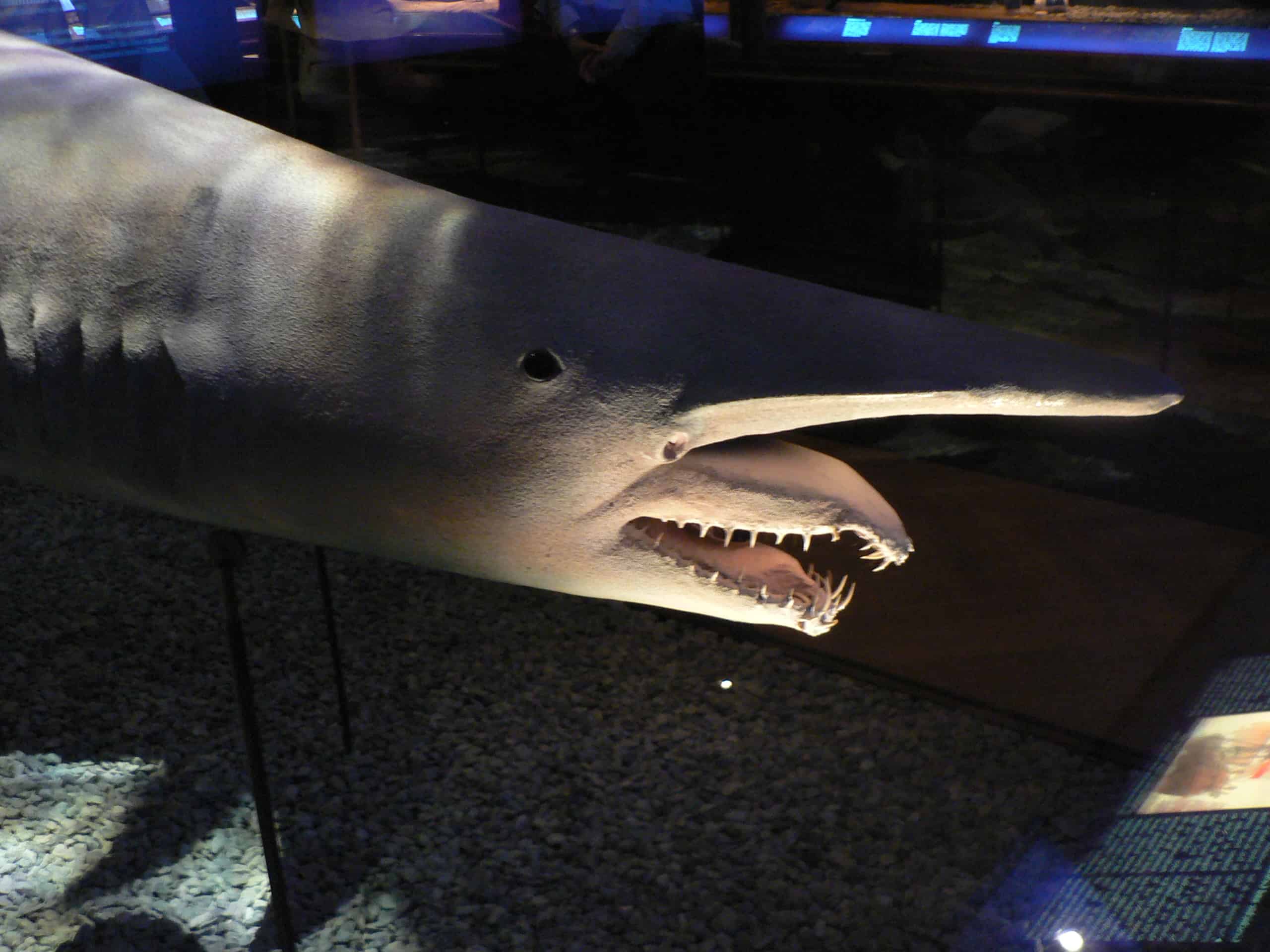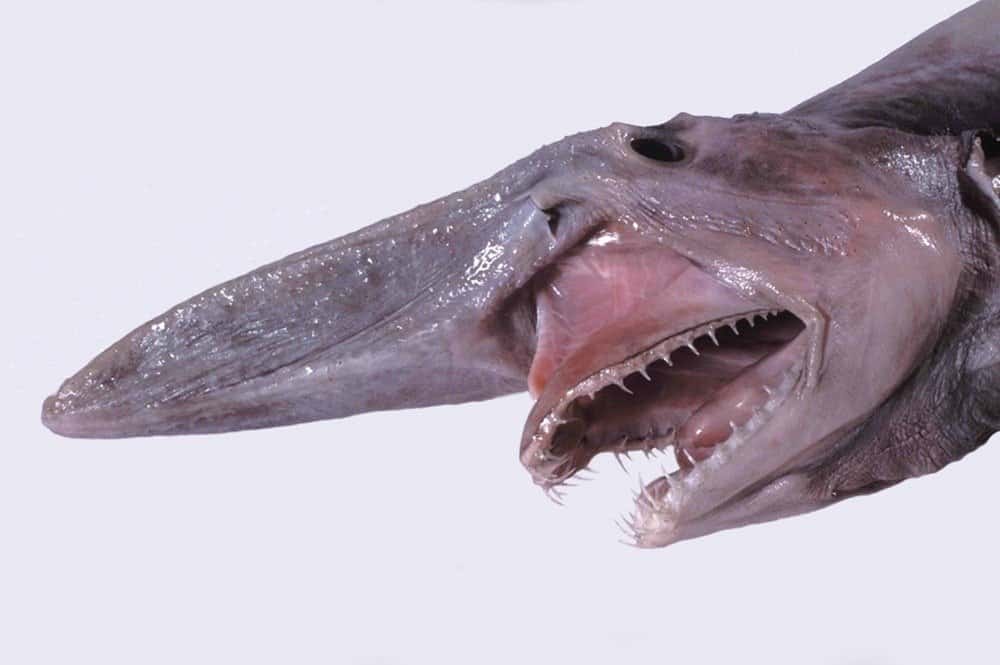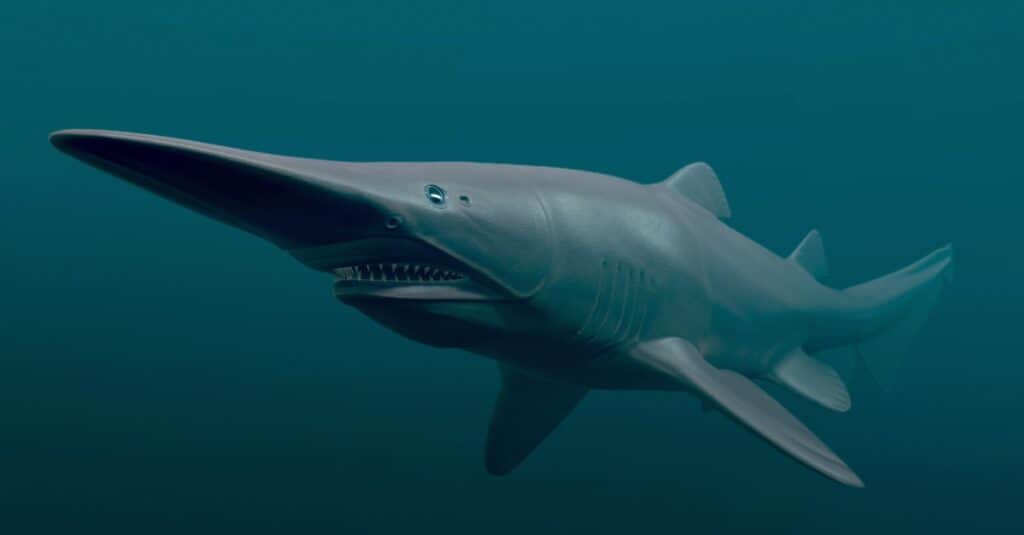Goblin sharks live near continental shelves or continent margins. Reaching up to 12 feet long and weighing as much as 460 pounds, these pink-hued creatures are massive. The goblin shark has a lot of unique characteristics. For example, its floppy fins reveal that it moves quite slowly. You can spot these strange-looking fish feeding mostly on the ocean floor. Interesting in learning more? Let’s explore 10 incredible goblin shark facts together!
1. The Goblin Shark Has A Few Unique Nicknames

The goblin shark is nicknamed “hobgoblin shark” in Spain and “imp shark” in France.
©Peter Halasz / CC BY-SA 3.0 – License
The goblin shark is also known as “The Living Fossil” because the family from which this peculiar-looking shark originates dates back millions of years. Despite having a vast range that spans parts of the Atlantic, Pacific, and Indian Oceans, the goblin shark is most frequently seen off the coastlines of Japan.
The sharks’ projecting snouts reminded Japanese fishers of the Tengu, a long-nosed, red-faced demon. They called it tenguzame. Shark is “zame” in Japanese. The monster is also sometimes termed an “elfin shark.”
2. Goblin Sharks Are Deep Sea Creatures
The goblin shark has been caught as deep as 4300 ft! At a depth of almost 4,500 feet, a goblin shark’s tooth was discovered embedded in an underwater cable. The occasional goblin shark has been reported to be discovered in shallow inshore waters of 130 feet. Mature ones are known to live in deeper water than youngsters. In the Gulf of Mexico, this strange fish has also been discovered in fishing nets.
3. Goblin Sharks Are Old As Dinosaurs
Around 125 million years ago, in the late Mesozoic epoch, the Mitsukurinidae family first emerged. This was around the time dinosaurs were on earth. The oldest Mitsukurina fossils date back 49–37 million years to the middle Eocene. The fossil species Mitsukurina lineata and Mitsukurina maslinensis have been identified so far.
4. The Goblin Shark Shrinks When It Gets Older

The goblin shark’s snout shrinks as it ages.
©Dianne Bray / Museum Victoria / CC BY 3.0 AU, Wikimedia Commons – License
The goblin shark has a long, flat snout that gets shorter as it gets older. They are so rare and enigmatic that it is impossible to understand why this is exactly.
5. Goblin Sharks Will Eat Just About Anything

Sadly, there is proof that goblin sharks are eating trash that is discovered close to the ocean floor.
©Juliana Motzko/Shutterstock.com
The goblin shark is an opportunistic bottom feeder and occasionally even consumes manufactured goods. Sadly, there is proof that goblin sharks are eating trash that is discovered close to the ocean floor, which is where they normally live.
6. The Color Of Goblin Sharks Changes Even More After Death
Post-mortem goblin sharks are all evenly brown or grey rather than pink. As a result, you can be confident that any image of a brown goblin shark you see is of a preserved dead one.
7. Goblin Sharks Are the Only Living Members of Their Family

The goblin shark is the only surviving member of its family, Mitsukurinidae.
©Peter Halasz (User:Pengo) / CC BY-SA 3.0, Wikimedia Commons – License
The family Mitsukurinidae probably developed during the Cretaceous epoch. These sharks had narrow, needle-like teeth at the front of their mouths, including the living goblin shark. Today, the goblin shark is the only member of this family that survives.
The great white and basking sharks are members of the order of sharks known as the Lamniformes, which includes the family Mitsukurinidae. Most species of Lamniformes have two dorsal fins and five-gill slits on either side of their body.
8. Goblin Sharks Have Different Types of Teeth Which Are Numerous In Numbers
There is a huge variance in the length and width of each individual tooth across the numerous rows of teeth they have. Teeth in the main jaw region of the goblin shark are long and narrow, and they get progressively thinner as they approach the jaw’s midpoint. These grooves run the length of the tooth and are quite fine. Incisors in the back rows, closer to the jaw’s corners, tend to be smaller and flatter.
9. Reproduction Of Goblin Shark Is Poorly Understood

Researchers say goblin sharks’ reproduction characteristics are likely identical to most mackerel sharks.
©iStock.com/3dsam79
No pregnancies have ever been detected in goblin sharks, making reproductive studies difficult. Researchers say reproduction characteristics are likely identical to most mackerel sharks. This implies small litter and embryo development during gestation. Born sharks are 32 to 36 inches long. Males mature at around 8 feet long.
10. Goblin Sharks Have An Adaptive Hunting Routine
As a slow swimmer with weak vision, the goblin shark hunts by ambush. Low-density flesh and an oily liver make the shark neutrally buoyant. A goblin shark can pursue a snack without making many motions that might warn the victim. The goblin shark’s jaws can snap forward when its prey is close, grabbing unaware fish or marine creatures.
The photo featured at the top of this post is © iStock.com/3dsam79
Thank you for reading! Have some feedback for us? Contact the AZ Animals editorial team.






